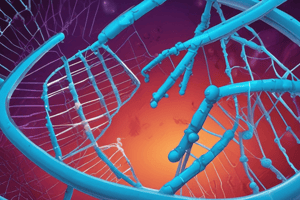Podcast
Questions and Answers
Which of the following is NOT a typical source material used for DNA isolation?
Which of the following is NOT a typical source material used for DNA isolation?
- Epithelial cells.
- Processed foods. (correct)
- Urine.
- Sperm.
During DNA isolation, what is the primary role of EDTA or NaCl in the cell extract preparation?
During DNA isolation, what is the primary role of EDTA or NaCl in the cell extract preparation?
- To precipitate DNA for easier collection.
- To remove $Mg^{2+}$ ions, preserving cell membrane structure. (correct)
- To disrupt cell membranes by removing lipids.
- To denature proteins and prevent DNA degradation.
What is the purpose of using SDS (Sodium Dodecyl Sulfate) in the preparation of a cell extract during DNA isolation?
What is the purpose of using SDS (Sodium Dodecyl Sulfate) in the preparation of a cell extract during DNA isolation?
- To disrupt the cell membranes by removing lipids. (correct)
- To inhibit the activity of DNases that could degrade the DNA.
- To remove proteins from the DNA sample.
- To precipitate the DNA for easier purification.
After cell lysis, which step is crucial for separating the DNA from cellular debris and other impurities?
After cell lysis, which step is crucial for separating the DNA from cellular debris and other impurities?
Which of the following methods is most frequently used to concentrate DNA samples after purification?
Which of the following methods is most frequently used to concentrate DNA samples after purification?
A researcher obtains an $A_{260}/A_{280}$ ratio of 1.5 for a DNA sample. What does this result indicate?
A researcher obtains an $A_{260}/A_{280}$ ratio of 1.5 for a DNA sample. What does this result indicate?
Which of the following is the correct order of main steps in DNA isolation?
Which of the following is the correct order of main steps in DNA isolation?
Which purification method relies on the use of a solid matrix to selectively bind DNA, allowing for the removal of impurities?
Which purification method relies on the use of a solid matrix to selectively bind DNA, allowing for the removal of impurities?
Flashcards
DNA Isolation Instruments
DNA Isolation Instruments
UV-spectrophotometer, Centrifuge, Vortex mixer, Micropipette, Microtube, Tips.
Importance of DNA Isolation
Importance of DNA Isolation
Genetic analysis, scientific, medical, or forensic purposes.
DNA Isolation Steps
DNA Isolation Steps
- Cell extract. 2. DNA purification. 3. Concentration. 4. Purity measurement.
Common DNA Sources
Common DNA Sources
Signup and view all the flashcards
Cell Extract Preparation
Cell Extract Preparation
Signup and view all the flashcards
DNA Isolation
DNA Isolation
Signup and view all the flashcards
DNA Purification Methods
DNA Purification Methods
Signup and view all the flashcards
DNA Concentration
DNA Concentration
Signup and view all the flashcards
Study Notes
- DNA isolation is purifying DNA using physical and chemical processes.
- Friedrich Miescher first isolated DNA in 1869.
Significance of DNA Isolation
- DNA isolation is crucial for genetic analysis, scientific research, medical applications, and forensic purposes.
- DNA isolation techniques provide pure DNA, free of contaminants.
Instruments
- UV-spectrophotometer
- Centrifuge or microfuge
- Vortex mixer
- Micropipette
- Microtube
- Tips
Main Steps of DNA Isolation
- Prepare a cell extract.
- Purify DNA from the cell extract.
- Concentrate the DNA samples.
- Measure the purity of the concentrated DNA.
Common DNA Sample Sources
- Whole blood, hair, sperm, bones, nails, and tissues
- Blood stains, saliva, and buccal (cheek) swabs containing epithelial cells
- Urine and paper cards used for sample collection
- Bacteria, animal tissues, or plants
Preparation of a Cell Extract
- Cells must be separated, and cell membranes need to be disrupted using Extraction Buffer to extract DNA.
- Ethylene Diamine Tetra Acetate (EDTA) or NaCl removes Mg2+ ions, preserving the cell membrane structure.
- Sodium Dodecyl Sulfate (SDS) disrupts cell membranes by removing lipids.
- Centrifugation or crushing results in a clear supernatant cell extract.
Purification of DNA From Cell Extract
- Impurities include: Detergents, salts and reagents used for cell lysis, cell debris, proteins, and RNA.
- Ethanol precipitation, Phenol-chloroform extraction, and Minicolumn purification (Chromatography) are the most common purification procedures.
Concentration of DNA Samples
- Ethanol precipitation is the most common method for concentration, using freezing ethanol.
- DNA is drawn with a glass rod.
- Then centrifuge the DNA.
Measurement of Purity of Concentrated DNA
- DNA concentrations are measured by UV-spectrophotometer at 260 nm and 280 nm.
- A (A260/A280) ratio of 1.8 indicates a pure DNA sample.
- A (A260/A280) ratio less than 1.8 signifies contamination with protein or phenol.
Applications of DNA Isolation
- Diagnosis of DNA Mutation, which is a sequence change in <1% of a population.
- Diagnosis of genetic polymorphism, which is a DNA sequence change in >1% of a population.
- Forensic medicine paternity testing.
- Forensic medicine identification of individuals.
- Medicine identification of specific sources of virulence of organisms in a community or hospital
- Constructing genome libraries.
Studying That Suits You
Use AI to generate personalized quizzes and flashcards to suit your learning preferences.




